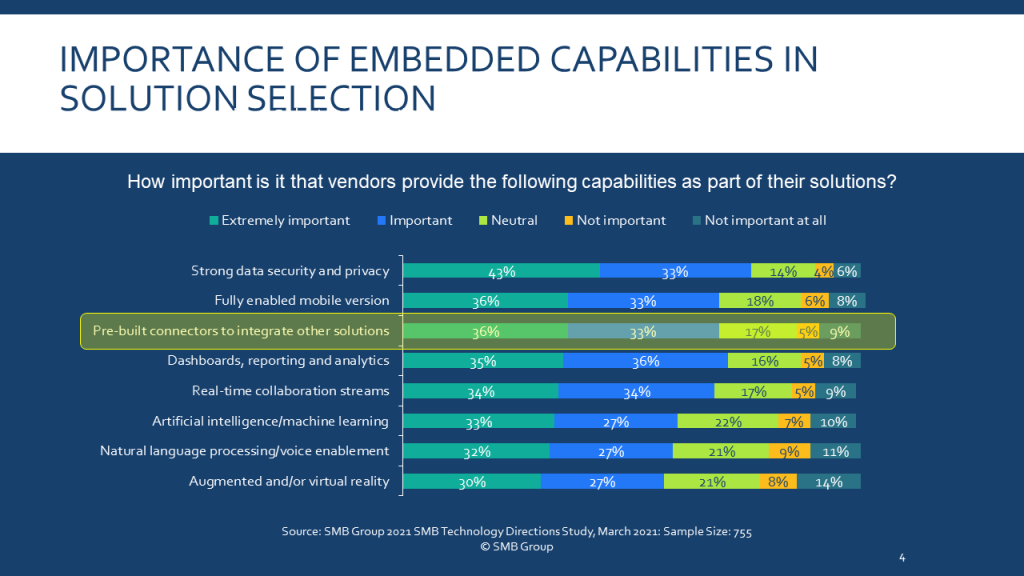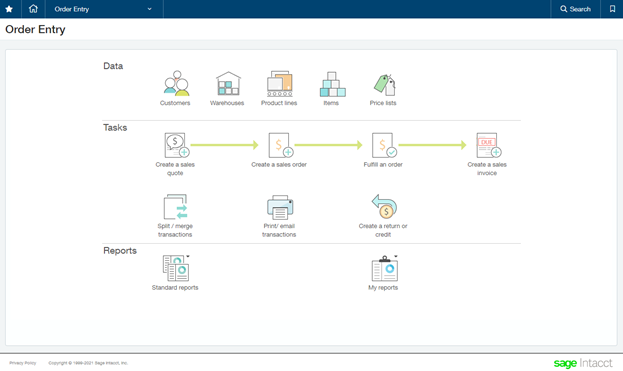The year 2020 was rough for many SMBs. But as COVID vaccinations ramp up, new COVID cases trend down, and consumer stimulus programs boost spending, 72% of SMBs are optimistic about their prospects for 2021.[1]
As SMBs gear up for a sunnier future, many are making changes to their business and technology strategies to help them capitalize on new opportunities. Over half plan to increase tech spending in 2021. Increasingly, they’ll be turning to the cloud to source new applications to meet new business goals.
However, while the cloud has made it much easier for SMBs to access and use new applications, integrating them isn’t always so straightforward. In fact, SMBs cite “integration difficulties” as one of the top three obstacles they face in implementing new solutions. Not surprising when you realize that although 62% of small businesses have at least partially integrated some applications, 79% still rely on clunky manual Excel file uploads or brittle, difficult-to-update custom code for some or all of these integrations.[2]
Strong integration is key to unlocking the full value of business applications
Integration is essential to helping SMBs secure the full business process value of new applications—and to gain a more unified, consistent view of the business. In today’s interconnected business world, a single business application is rarely used as a standalone solution. If your company uses a CRM system, such as Salesforce, you want to integrate it with your financials and accounting solution to get a complete view of the customer.
But there are multiple ways to integrate solutions—from custom code to direct integrations to third-party integrations. The scope and quality of these integrations can vary widely. Just because a vendor tells you they have a way to integrate that new application with one you’ve been using doesn’t mean the integration will be easy, work well, be affordable, or be easy to update. Many SMBs have found out the hard way that trying to connect different applications “after the fact” can be a costly, time-consuming and not always successful endeavor. In contrast, ready-made integrations provide a proven, out-of-the-box integration that can save you time, money, and labor.
As a result, more SMBs are looking for pre-built connectors upfront, as part of the solution selection process. Among SMBs, 69% say that it is extremely important or important for vendors to have pre-built connectors or integrations to other solutions as part of the solution package.
Sage Intacct: placing a premium on integration
The Sage Intacct Marketplace Partner program (MPP) (please provide link) focuses on partner quality, not quantity. Sage Intacct works with more than 200 partners to provide its customers with access to best-of-breed solutions and easy, seamless integrations.Customers will find two types of integrations in the Sage Intacct Marketplace: those written by Sage Intacct and those written by partners.
Sage writes its own integrations for a handful of the most frequently requested best-of-breed integrations, such as with Salesforce CRM and Avalara Tax. In most other cases, partners write integrations with Sage Intacct—but Sage Intacct carefully vets, monitors, and tests partner integrations before they are released. Thanks to this due diligence, 75% of Sage Intacct customers have integrated two or more Marketplace solutions with Sage Intacct.
Sage’s strong application programming interfaces (APIs) provide a solid foundation for these integrations. Simply put, an API is a set of programming code that enables applications to talk to each by transmitting data from one application to another. But not all APIs are created equal. Some of them make integration easy, while others make it difficult. Sage Intacct has designed its API to be simple, consistent, and predictable for developers to use—making it attractive to both third-party developers and customers.
Sage Intacct and Salesforce integration
Many Sage Intacct customers use Salesforce’s market leading CRM solution, so Sage Intacct developed an Advanced Salesforce Integration) for them. Built on the Salesforce platform, this integration provides a complete view of every customer, and automates the order-to-cash process.
Joint customers can integrate Sage Intacct with Salesforce with a simple exchange of credential codes, eliminating the need for costly and time-consuming third-party integrations. Salesforce users can send contracts, orders, and other information directly from Salesforce to Sage Intacct in one click. Once the data is in Sage Intacct, it triggers invoicing and revenue recognition—providing more accurate billing and a faster billing process.
Salespeople work in Salesforce and can see billing and payments from there, while accounting people work in Sage Intacct—but everyone sees the same, real-time information. Salesforce Chatter is integrated with Sage Intacct Collaborate, so sales and finance can collaborate in real-time to take care of approvals, clarify policies, and resolve exceptions—instead of wasting time sending emails.
This integration was a key reason that Plexxi, which created the industry’s first affinity driven networking products, selected Sage Intacct when it needed to move from QuickBooks to a more robust accounting solution. Plexxi uses the functionality described above and has also built Salesforce triggers with Sage Intacct to help its service organization track assets, contracts and entitlements for specific customers and product serial numbers. Plexxi estimates that the integration has saved $50,000 over what it would have cost to do a custom integration in another system. As important, the integration helps Plexxi’s service reps better manage customer renewals and open service cases.
Sage Intacct Marketplace Partners—curated to provide customer value
The focus of the Sage Intacct Marketplace is to deliver high-quality, best-of-breed solutions that integrate with Sage Intacct. To ensure the partner is a good fit for Sage Intacct customers, the vendor puts potential partners through a stringent business and technical vetting process.
On the business side, partners need to have a strong overlap in terms of target market, customers, and pricing with Sage Intacct. On the technology side, Sage Intacct evaluates whether the right data connection points exist for an integration and whether the planned integration will be robust enough for customers. For example, does the integration provide meaningful information to improve the customer’s financial processes or financial information to improve the external process? Sage Intacct often turns away potential partners from MPP because they miss the mark on business or technical criteria.
When a partner is a good fit, they become an official Marketplace Partner and gain access to architect level resources for questions on application programming interfaces (APIs), configurations, and best practices. Partners can talk to in-house specialists for questions on anything from XML to detailed functionality of specific Sage Intacct modules that they need to connect to perform focused integrations. For instance, a partner building a warehouse management integration has access to in-house inventory specialists to understand the data connection points for performing all the various tasks involved in receiving and tracking inventory in the system.
Once the MPP completes the integration, Sage Intacct conducts two levels of reviews before the partner is listed on the Marketplace web page. The reviews cover several areas, including:
- Security, such as are there any exposed passwords, is the IT address filtering working properly, etc.
- Functionality, to ensure that integration supports the business entities and in-depth reporting features.
- Documentation for the integration.
- Support processes, to confirm that the hours the MPP is open for support and who will answer support calls.
- Load testing to ascertain that integration can support high data volumes.
Once the application passes the review, its added it to the MarketPlace so customers can quickly find new applications they need—and the assurance that they will integrate with Sage Intaact.
Sasser Family Companies, a fourth-generation, family-held transportation assets services and management company, was sold on Sage Intacct not only because it offered robust multi-entity management and reporting capabilities, but also because Sage Intacct’s open APIs would facilitate straightforward integrations with both homegrown applications and third-party solutions.
Perspective
Best of breed applications are great, but in today’s business world, SMBs can’t afford siloed applications. Great integrations move data between applications and connect workflows—helping you improve productivity and streamline business processes. As important, they help you see the big picture across different business functions—giving you the insights you need to identify and respond to new opportunities or potential problems much more quickly and easily.
By assessing integration capabilities upfront in the application selection process, you can ensure that you’ll be able to reap these integration benefits more quickly, easily and cost-effectively than if integration is an after-thought.
© SMB Group, 2021
[1] Source: SMB Group 2021 SMB Technology Directions Study, March 2021: Sample Size: 755
[2] Source: SMB Group SMB 360: Connecting the Dots Between Business and Technology Study, February 2019; Sample Size: 701
This is post is sponsored by Sage Intacct, and was originally published here.
Source: Laurie McCabe’s Blog





